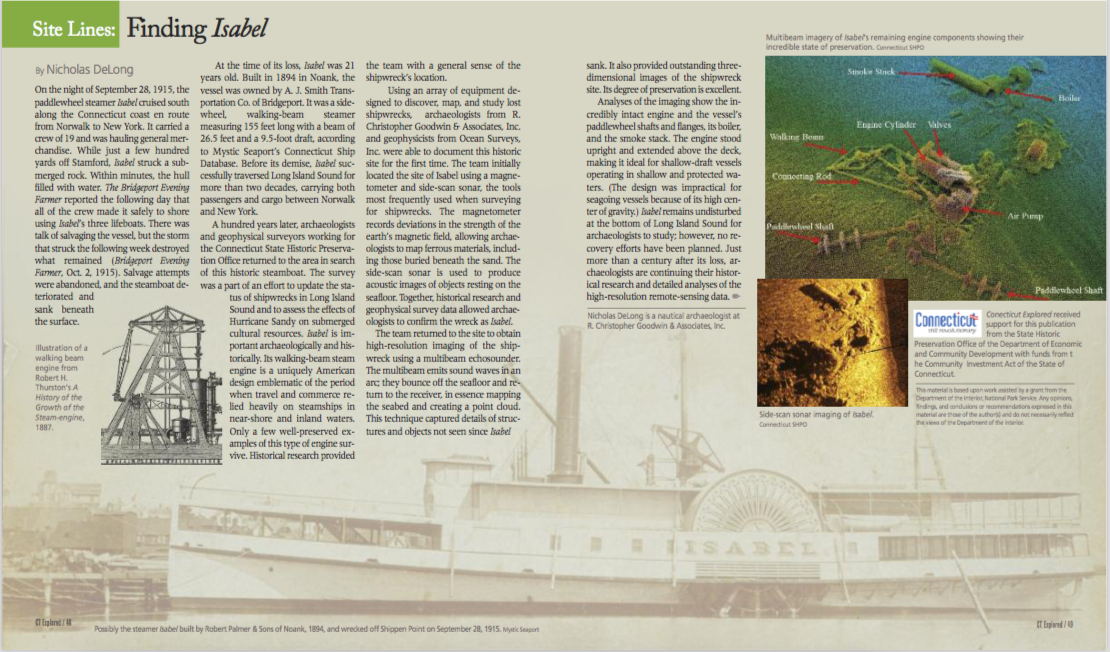By Nicholas DeLong
(c) Connecticut Explored Inc. Spring 2018
Subscribe/Buy the Issue!
On the night of September 28, 1915, the paddlewheel steamer Isabel cruised south along the Connecticut coast en route from Norwalk to New York. It carried a crew of 19 and was hauling general merchandise. While just a few hundred yards off Stamford, Isabel struck a submerged rock. Within minutes, the hull filled with water. The Bridgeport Evening Farmer reported the following day that all of the crew made it safely to shore using Isabel’s three lifeboats. There was talk of salvaging the vessel, but the storm that struck the following week destroyed what remained (Bridgeport Evening Farmer, Oct. 2, 1915). Salvage attempts were abandoned, and the steamboat deteriorated and sank beneath the surface.
At the time of its loss, Isabel was 21 years old. Built in 1894 in Noank, the vessel was owned by A. J. Smith Transportation Co. of Bridgeport. It was a sidewheel, walking-beam steamer measuring 155 feet long with a beam of 26.5 feet and a 9.5-foot draft, according to Mystic Seaport’s Connecticut Ship Database. Before its demise, Isabel successfully traversed Long Island Sound for more than two decades, carrying both passengers and cargo between Norwalk and New York.
A hundred years later, archaeologists and geophysical surveyors working for the Connecticut State Historic Preservation Office returned to the area in search of this historic steamboat. The survey was a part of an effort to update the status of shipwrecks in Long Island Sound and to assess the effects of Hurricane Sandy on submerged cultural resources. Isabel is important archaeologically and historically. Its walking-beam steam engine is a uniquely American design emblematic of the period when travel and commerce relied heavily on steamships in near-shore and inland waters. Only a few well-preserved examples of this type of engine survive. Historical research provided the team with a general sense of the shipwreck’s location.
Using an array of equipment designed to discover, map, and study lost shipwrecks, archaeologists from R. Christopher Goodwin & Associates, Inc. and geophysicists from Ocean Surveys, Inc. were able to document this historic site for the first time. The team initially located the site of Isabel using a magnetometer and side-scan sonar, the tools most frequently used when surveying for shipwrecks. The magnetometer records deviations in the strength of the earth’s magnetic field, allowing archaeologists to map ferrous materials, including those buried beneath the sand. The side-scan sonar is used to produce acoustic images of objects resting on the seafloor. Together, historical research and geophysical survey data allowed archaeologists to confirm the wreck as Isabel.
The team returned to the site to obtain high-resolution imaging of the shipwreck using a multibeam echosounder. The multibeam emits sound waves in an arc; they bounce off the seafloor and return to the receiver, in essence mapping the seabed and creating a point cloud. This technique captured details of structures and objects not seen since Isabel sank. It also provided outstanding three-dimensional images of the shipwreck site. Its degree of preservation is excellent.
Analyses of the imaging show the incredibly intact engine and the vessel’s paddlewheel shafts and flanges, its boiler, and the smoke stack. The engine stood upright and extended above the deck, making it ideal for shallow-draft vessels operating in shallow and protected waters. (The design was impractical for seagoing vessels because of its high center of gravity.) Isabel remains undisturbed at the bottom of Long Island Sound for archaeologists to study; however, no recovery efforts have been planned. Just more than a century after its loss, archaeologists are continuing their historical research and detailed analyses of the high-resolution remote-sensing data.
Nicholas DeLong is a nautical archaeologist at R. Christopher Goodwin & Associates, Inc.
 Connecticut Explored received support for this publication from the State Historic Preservation Office of the Department of Economic and Community Development with funds from the Community Investment Act of the State of Connecticut.
Connecticut Explored received support for this publication from the State Historic Preservation Office of the Department of Economic and Community Development with funds from the Community Investment Act of the State of Connecticut.
This material is based upon work assisted by a grant from the Department of the Interior, National Park Service. Any opinions, findings, and conclusions or recommendations expressed in this material are those of the author(s) and do not necessarily reflect the views of the Department of the Interior.

